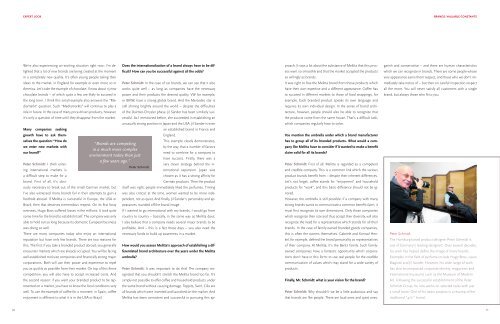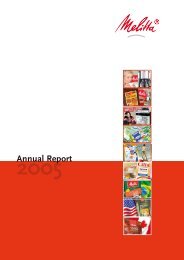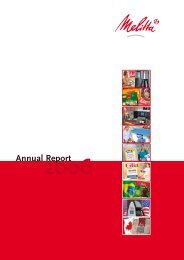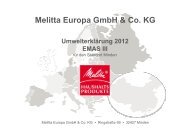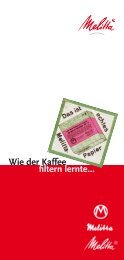Download as PDF - Melitta
Download as PDF - Melitta
Download as PDF - Melitta
You also want an ePaper? Increase the reach of your titles
YUMPU automatically turns print PDFs into web optimized ePapers that Google loves.
expert look<br />
We’re also experiencing an exciting situation right now: I’m delighted<br />
that a lot of new brands are being created at the moment<br />
in a completely new quality. It’s often young people taking their<br />
ide<strong>as</strong> to the market, in England for example or even more so in<br />
America. Let’s take the example of chocolate: I know about 15 new<br />
chocolate brands – of which quite a few are likely to succeed in<br />
the long term. I think this small example also answers the “Mediamarkt”<br />
question. Such “Mediamarkts” will continue to play a<br />
role in future. In the c<strong>as</strong>e of many price-driven products, however,<br />
it’s only a question of time until they disappear from the market.<br />
does the internationalization of a brand always have to be difficult?<br />
How can you be successful against all the odds?<br />
peter schmidt: In the c<strong>as</strong>e of car brands, we can see that it also<br />
works quite well – <strong>as</strong> long <strong>as</strong> companies have the necessary<br />
power and their products the desired quality. VW for example,<br />
or BMW, have a strong global brand. And the Mercedes star is<br />
still shining brightly around the world – despite the difficulties<br />
of the Daimler-Chrysler ph<strong>as</strong>e. Jil Sander h<strong>as</strong> been similarly successful.<br />
As I mentioned before, she succeeded in establishing an<br />
unusually strong position in Japan and the USA. Jil Sander is even<br />
Many companies seeking<br />
an established brand in France and<br />
growth have to <strong>as</strong>k them-<br />
England.<br />
selves the question: “How do<br />
we enter new markets with<br />
our brand?”<br />
peter schmidt: I think entering<br />
international markets is<br />
“Brands are competing<br />
in a much more complex<br />
environment today than just<br />
a few years ago.”<br />
Peter Schmidt<br />
This example clearly demonstrates,<br />
by the way, that a number of factors<br />
need to combine for a company to<br />
have success. Firstly, there w<strong>as</strong> a<br />
very clever strategy behind the international<br />
expansion. Japan w<strong>as</strong><br />
a difficult step to make for a<br />
chosen <strong>as</strong> it h<strong>as</strong> a strong affinity for<br />
brand. First of all, it’s obvi-<br />
German products. Then the product<br />
ously necessary to break out of the small German market, but itself w<strong>as</strong> right; people immediately liked the perfumes. Timing<br />
I’ve also witnessed many brands fail in their attempts to gain a w<strong>as</strong> also critical: at the time, women wanted to be more inde-<br />
foothold abroad. If <strong>Melitta</strong> is successful in Europe, the USA or pendent, not <strong>as</strong> quiet. And finally, Jil Sander’s personality and ap-<br />
Brazil, then that deserves tremendous respect. On its first foray pearances rounded off the brand image.<br />
overse<strong>as</strong>, Hugo Boss suffered losses in the millions. It took quite If I wanted to go international with my brands, I would go from<br />
some time for the brand to establish itself. The company w<strong>as</strong> only country to country – b<strong>as</strong>ically, in the same way <strong>as</strong> <strong>Melitta</strong> does.<br />
able to hold out so long because its domestic European business I also believe that a company needs several major brands to be<br />
w<strong>as</strong> doing so well.<br />
profitable. And – this is a fact these days – you also need the<br />
There are many companies today who enjoy an international<br />
reputation but have only few brands. There are two re<strong>as</strong>ons for<br />
necessary funds to build up awareness in a market.<br />
this. The first: if you take a branded product abroad, you generally How would you <strong>as</strong>sess <strong>Melitta</strong>’s approach of establishing a dif-<br />
encounter markets which are already occupied. You will be facing ferentiated brand architecture over the years under the <strong>Melitta</strong><br />
well-established mid-size companies and financially strong major<br />
corporations. Both will use their power and experience to repel<br />
umbrella?<br />
you <strong>as</strong> quickly <strong>as</strong> possible from their market. On top of this fierce peter schmidt: It w<strong>as</strong> important to do this! The company rec-<br />
competition, you will also have to accept incre<strong>as</strong>ed costs. And ognized that you shouldn’t stretch the <strong>Melitta</strong> brand too far. It’s<br />
the second re<strong>as</strong>on: if you want your branded product to be rep- simply not possible to offer coffee and household products under<br />
resented on a market, you have to know the local conditions very the same brand without causing damage. Toppits, Swirl, Cilia are<br />
well. To use the example of coffee for a moment: in Spain, coffee all brands which were invented and launched on the market. And<br />
enjoyment is different to what it is in the USA or Brazil.<br />
<strong>Melitta</strong> h<strong>as</strong> been consistent and successful in pursuing this ap-<br />
proach. It says a lot about the substance of <strong>Melitta</strong> that this process<br />
went so smoothly and that the market accepted the products<br />
so willingly <strong>as</strong> brands.<br />
It w<strong>as</strong> right to free the <strong>Melitta</strong> brand from those products which<br />
have their own expertise and a different appearance. Coffee h<strong>as</strong><br />
to succeed in different markets to those of food wrappings, for<br />
example. Each branded product speaks its own language and<br />
requires its own individual design. In the sense of brand architecture,<br />
however, people should also be able to recognize that<br />
the products come from the same house. That’s a difficult t<strong>as</strong>k,<br />
which companies regularly have to solve.<br />
You mention the umbrella under which a brand manufacturer<br />
h<strong>as</strong> to group all of its branded products. What would a company<br />
like <strong>Melitta</strong> have to consider if it wanted to make a benefit<br />
claim valid for all its brands?<br />
peter schmidt: First of all: <strong>Melitta</strong> is regarded <strong>as</strong> a competent<br />
and credible company. This is a common link which the various<br />
product brands benefit from – despite their inherent differences.<br />
Let’s not forget, coffee stands for “enjoyment” and household<br />
products for “work”, and this b<strong>as</strong>ic difference should not be ignored.<br />
However, the umbrella is still possible: if a company with many<br />
strong brands wants to communicate a common benefit claim, it<br />
must first recognize its own dimensions. Only those companies<br />
which recognize their size and thus accept their diversity, will also<br />
recognize the need for a representative which stands for all their<br />
brands. In the c<strong>as</strong>e of family-owned branded goods companies,<br />
this is often the owners themselves. Gabriele and Konrad Henkel,<br />
for example, defined the brand personality <strong>as</strong> representatives<br />
of their company. At <strong>Melitta</strong>, it’s the Bentz family. Such familyowned<br />
companies have a fant<strong>as</strong>tic opportunity which corporations<br />
don’t have in this form: to use real people for the credible<br />
communication of values which may stand for a wide variety of<br />
products.<br />
Finally, Mr. schmidt: what is your vision for the brand?<br />
peter schmidt: Why shouldn’t we be a little audacious and say<br />
that brands are like people. There are loud ones and quiet ones,<br />
Brands: ValuaBle Constants<br />
garish and conservative – and there are human characteristics<br />
which we can recognize in brands. There are some people whose<br />
very appearance earns them respect, and those who we don’t immediately<br />
take notice of – but then on careful inspection respect<br />
all the more. You will never satisfy all customers with a single<br />
brand, but always those who fit to you.<br />
Peter Schmidt<br />
The Hamburg-b<strong>as</strong>ed product designer Peter Schmidt is<br />
one of Germany’s leading designers. Over several decades,<br />
his work h<strong>as</strong> helped define the image of many brands.<br />
Examples in the field of perfume include Hugo Boss, Laura<br />
Biagiotti and Jil Sander. However, his wide range of work<br />
h<strong>as</strong> also encomp<strong>as</strong>sed corporate identity, magazines and<br />
international museums such <strong>as</strong> the Museum of Modern<br />
Art. Following the successful establishment of the Peter<br />
Schmidt Group, he now works on selected t<strong>as</strong>ks with just<br />
a small team. One of his latest projects is a revamp of the<br />
traditional “4711” brand.<br />
10 11


